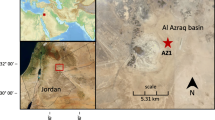Abstract
Fine-grained disseminated carbonate was found in Holocene sediments in a core taken from the northern basin of Lake Baikal. The core had two distinct facies, a terrigenous blue-clay overlain by a diatomaceous silt. Oxygen and carbon stable isotope analyses, combined with SEM, X-ray diffraction and palynology, show that the carbonate in the blue-clay layer is pedogenic in origin, rather than biogenic or authigenic. The δ13C values in the blue clay suggest that the carbonate is derived from a single source, while the carbonate in the diatom-rich layer might be transported by winds from different sources. On the assumption that the carbonate was formed during the post-glacial age and was transported primarily by river runoff, the δ18O isotopic values suggest that the annual temperature in the northern Baikal drainage area was about 3°C warmer during the middle. Holocene (8500–7000 a, B. P.) than during the early Holocene (11000–8500a, B. P.) when the blue clay was being deposited. This interpretation, is consistent with the dominant vegetation consisting of grasses in the northern Baikal drainage area prior to 7000a, B. P.,
Similar content being viewed by others
References
Abell, P. I., 1982. Palaeoclimate at Lake Turkana from oxygen isotope ratios of gastropod shells.Nature 297: 321–323.
Bezrukova, E. V., Bogdanoy, Yu. A., Williams D. F. et al., 1991. A dramatic change of the ecological system of Lake Baikal in the Holocene. Doklady Akad. Nauk.
Burgis, M. J. and Morris, P., 1987. The Natural History of Lakes. Cambridge University Press, New York.
Cerling, T. E., 1984. The stable isotopic composition of modern soil carbonate and its relationship to climate.Earth and Planetary Science Letters 71: 229–240.
Cerling, T. E., Quade, J., Wang, Y. et al., 1989. Carbon isotopes in soils and palaeosols as ecology and palaeoecology indicators.Nature 341: 138–139.
Craig, H., 1957. Isotopic standards for carbon and oxygen and correction factors for mass spectrometric analysis of carbon dioxide.Geochim. et Cosmochim. Acta 12: 133–149.
Dansgaard, W., 1964. Stable isotopes in precipitationTellus 16: 436–468.
Dorr, H. and Munnich, K. O., 1980. Carbon-14 and carbon-13 in soil CO2.Radiocarbon 22: 909–918.
Falkner, K. K., Measures, C. I., Herbelin, S. E. et al., 1991. The major and minor element geochemistry of Lake Baikal.Limnology Oceanography 36: 413–423.
Fritz, P. and Poplawski, S., 197418O and13C in the shells of freshwater molluscs and their environment.Earth and Planet Sci. Lett. 24: 91–98.
Galimov, E. M., 1966. Carbon isotopes in soil CO2.Geochem. Int. 3: 889–897.
Gat, J. R., 1980. The isotopes of hydrogen and oxygen in precipitation.In: Fritz, A. P. and Fontes, J. Ch., ed. Handbook of Environmental Isotope Geochemistry: 1. The Terrestrial Environment. Elsevier. Amsterdam, pp. 21–47.
Goldyrev, G. S., 1982. The Sedimentation and Quaternary, History of the Lake Baikal Basin. Novosibirsk, 182 pp. (in Russian).
Hulsemann, J., 1966. On the routine analysis of carbonates in unconsolidated sediments.Jour. Sed. Pet. 36: 622–625.
Ishiwatari, R., Takamatsu, N. and Ishibashi, T., 1977. Separation of autochthonous and allochthonous materials in lacustrine sediments by density differences.Japan. J. Limnol. 38: 94–99.
Kelts, K. and Talbot, M., 1990. Lacustrine carbonates as geochemical archives of environmental changes and biotic/abiotic interaction.In: Tilzer, M. M., and Serruya, C., ed. Large Lakes: Ecological Structure and Function. Springer-Verlag, New York, pp. 288–315.
Khotinskiy, N. A., 1984. Holocene vegetation history.In: Velichko, A. A., ed. Late Quaternary Environments of the Soviet Union. University of Minnesota Press, Minneapolis, pp. 179–200.
Kozhov, M., 1963. Lake Baikal and Its Life, Dr. W. Junk Publishers, The Hague, 339 pp.
Li, T., Zheng, Y. and Wang, Y. (ed.), 1983. Pedogeography. Higher Education Press, Beijing, 280 pp.
McCrea, J. M., 1950. On the isotopic chemistry of carbonates and a paleotemperature scale.Jour. Chem. Phys.,18(6): 849–857.
McKenzie, J. A., 1985. Carbon isotopes and productivity in the lacustrine and marine environment.In: Stumm, W., ed. Chemical Processes in Lakes. John Wiley & Sons, New York, pp. 99–118.
Rightmire, C. T. and Hanshaw B. B., 1973. Relationship between the carbon isotope composition of soil CO2 and dissolved carbonate species in groundwater.Water Resour. Res. 9: 958–967.
Rightmire, C. T., 1978. Seasonal variation in pCO2 and13C content of soil atmosphere.Water Resour. Res. 14: 691–692.
Schlesinger, W. H., Marion, G. M. and Fonteyn, P. J., 1988. Stable isotope ratios and the dynamics of caliche in desert soils.In: Rundel, P. W., Ehleringer, J. R. and Nagy, K. A., ed. Stable Isotopes in Ecological Research. Springer-Verlag, New York pp. 308–317.
Stuiver, M., 1970. Oxygen and carbon isotope ratios of freshwater carbonates as climatic indicators.J. Geophys. Res. 75: 5247–5257.
Swain, F. M., 1970. Non-marine Organic Geochemistry. Cambridge University Press, New York.
Talma, A. S. and Nettergerg, F., 1983. Stable isotope abundances calcretes.In: Wilson, R. C. L., ed., Residual Deposits: Surface Related Weathering Processes and Materials. Blackwell Scientific Publishers, London, pp. 221–233.
Teeri, J. A. and Stowe L. G., 1976. Climate patterns and the distribution of C4 grasses in Northern America.Oecologia 23: 1–12.
Volkov, I. A. and Zykina, V. S., 1984. Loess stratigraphy in southwestern, Siberia.In: Velichko, ed. Late Quaternary Environments of the Soviet Union. University of Minnesota Press, Minneapolis, pp. 119–124.
Zhadin, V. I. and Gerd, S. V., 1961. Fauna and flora of the rivers lakes and reservoirs of the U. S. S. R., Isarael Program for Scientific Translations, Jerusalem 1963.
Zubakov, V. A. and Borzenkova, I. I., 1990. Global Paleoclimate of the Late Cenozoic. Elsevier. Amsterdam.
Author information
Authors and Affiliations
Rights and permissions
About this article
Cite this article
Linqing, Q., Williams, D.F. Origin of carbonate materials in the northern Basin of Lake Baikal and its relationship to holocene paleoclimate. Chin. J. Ocean. Limnol. 11, 57–69 (1993). https://doi.org/10.1007/BF02850728
Received:
Issue Date:
DOI: https://doi.org/10.1007/BF02850728




